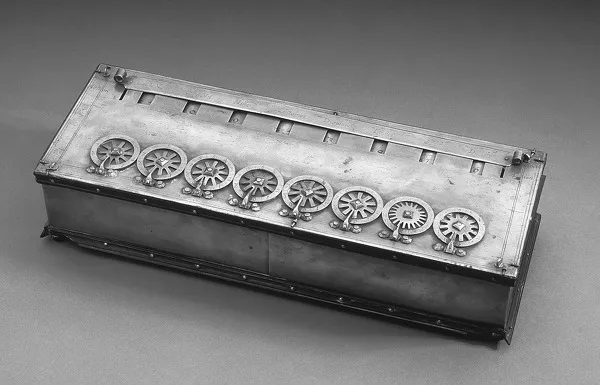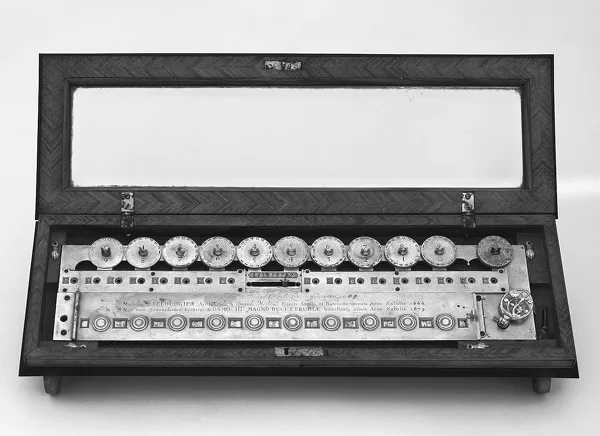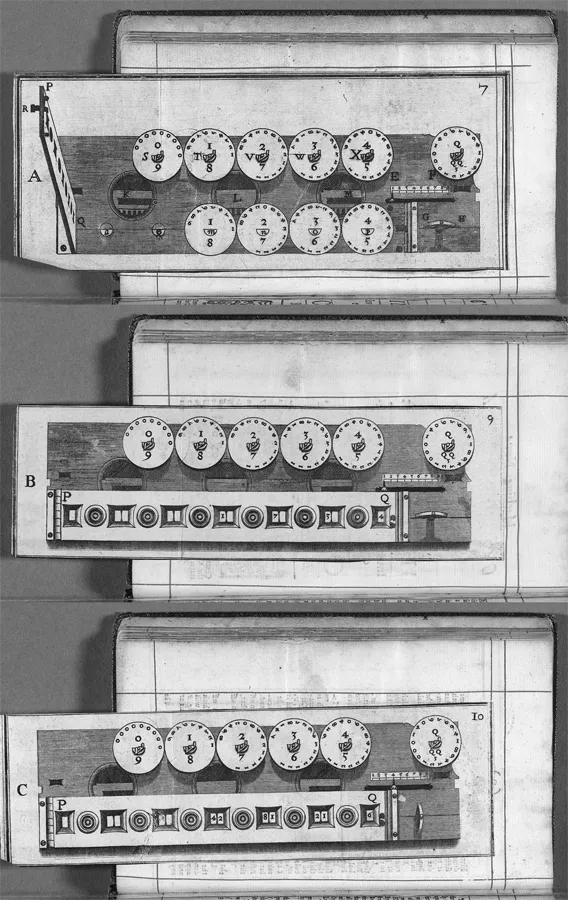
eBook - ePub
Reckoning with Matter
Calculating Machines, Innovation, and Thinking about Thinking from Pascal to Babbage
- English
- ePUB (mobile friendly)
- Available on iOS & Android
eBook - ePub
Reckoning with Matter
Calculating Machines, Innovation, and Thinking about Thinking from Pascal to Babbage
About this book
From Blaise Pascal in the 1600s to Charles Babbage in the first half of the nineteenth century, inventors struggled to create the first calculating machines. All failed—but that does not mean we cannot learn from the trail of ideas, correspondence, machines, and arguments they left behind.
In Reckoning with Matter, Matthew L. Jones draws on the remarkably extensive and well-preserved records of the quest to explore the concrete processes involved in imagining, elaborating, testing, and building calculating machines. He explores the writings of philosophers, engineers, and craftspeople, showing how they thought about technical novelty, their distinctive areas of expertise, and ways they could coordinate their efforts. In doing so, Jones argues that the conceptions of creativity and making they exhibited are often more incisive—and more honest—than those that dominate our current legal, political, and aesthetic culture.
In Reckoning with Matter, Matthew L. Jones draws on the remarkably extensive and well-preserved records of the quest to explore the concrete processes involved in imagining, elaborating, testing, and building calculating machines. He explores the writings of philosophers, engineers, and craftspeople, showing how they thought about technical novelty, their distinctive areas of expertise, and ways they could coordinate their efforts. In doing so, Jones argues that the conceptions of creativity and making they exhibited are often more incisive—and more honest—than those that dominate our current legal, political, and aesthetic culture.
Frequently asked questions
Yes, you can cancel anytime from the Subscription tab in your account settings on the Perlego website. Your subscription will stay active until the end of your current billing period. Learn how to cancel your subscription.
No, books cannot be downloaded as external files, such as PDFs, for use outside of Perlego. However, you can download books within the Perlego app for offline reading on mobile or tablet. Learn more here.
Perlego offers two plans: Essential and Complete
- Essential is ideal for learners and professionals who enjoy exploring a wide range of subjects. Access the Essential Library with 800,000+ trusted titles and best-sellers across business, personal growth, and the humanities. Includes unlimited reading time and Standard Read Aloud voice.
- Complete: Perfect for advanced learners and researchers needing full, unrestricted access. Unlock 1.4M+ books across hundreds of subjects, including academic and specialized titles. The Complete Plan also includes advanced features like Premium Read Aloud and Research Assistant.
We are an online textbook subscription service, where you can get access to an entire online library for less than the price of a single book per month. With over 1 million books across 1000+ topics, we’ve got you covered! Learn more here.
Look out for the read-aloud symbol on your next book to see if you can listen to it. The read-aloud tool reads text aloud for you, highlighting the text as it is being read. You can pause it, speed it up and slow it down. Learn more here.
Yes! You can use the Perlego app on both iOS or Android devices to read anytime, anywhere — even offline. Perfect for commutes or when you’re on the go.
Please note we cannot support devices running on iOS 13 and Android 7 or earlier. Learn more about using the app.
Please note we cannot support devices running on iOS 13 and Android 7 or earlier. Learn more about using the app.
Yes, you can access Reckoning with Matter by Matthew L. Jones in PDF and/or ePUB format, as well as other popular books in Biological Sciences & Computer Science General. We have over one million books available in our catalogue for you to explore.
Information
1
Carrying Tens: Pascal, Morland, and the Challenge of Machine Calculation
In a letter of September 1646, Pierre Petit, engineer to the king, wrote a short history of techniques for facilitating arithmetical procedures. The most important development since logarithms was Blaise Pascal’s arithmetical machine, a “piece invented truly with as much good fortune and speculation as its author has wit and knowledge” (see figure 1.1). Petit tempered his praise: “Since it comprises a number of wheels, springs and movement, and since it requires the head and hands of a good watchmaker to understand it and put it into practice, as well as the skill and knowledge of a good Arithmetician to be able to use it, I fear that its use will never become common.” He accurately predicted that the machine would end up “in cabinets and great libraries,” not in government bureaus and trading houses as Pascal had hoped.1 Contemporaries echoed Petit’s concerns. One collector of gossip noted that only one artisan in Rouen could build the machine, and only with Pascal present.2 The projector and sometime fugitive Sir Balthasar Gerbier concluded his 1648 description of Pascal’s machine by noting that “a man must first be exact jn Arithmeticke before he can make use of this Instrument, which cost 50 pistols.” He deemed the machine “a Rare Invention farre saught, and deare baught: putt them jn the Storre house was the Prince of Orange wont to saye and lett us proceede on the ordinary readdy way.”3

FIGURE 1.1. Machine arithmétique de Pascal à chiffres plus sous et deniers, 1645. Inventory no. 19600-0001. Closed view. (© Musée des arts et métiers-CNAM, Paris. Photo: J-C Wetzel.)
In setting forth the impracticalities of Pascal’s machine, Petit stressed its dependence on two forms of skill: that of the arithmetician and that of the watchmaker. The machine did not obviate the skills involved in doing arithmetic. Making something as complex as a calculating machine capable of performing addition and subtraction depended likewise on superior artisanal skills. The design of the machine was not sufficiently simple to allow ordinary artisans to produce it easily in a merely imitative, or a fairly machinelike, fashion—what David Pye calls the “craftsmanship of certainty.” Its production, like its devising, required creativity and improvisation—the “craftsmanship of risk.”4 The superior skills and creative problem solving necessary to build Pascal’s machine meant that ordinary watchmakers or other artisans could not produce the machines in any standardized fashion. As a consequence, Pascal’s machines were too dear for his envisioned markets of merchants, government tax officials, and architects.5
Using the examples of the calculating machines of Blaise Pascal and Sir Samuel Morland from the seventeenth century, this chapter investigates the skills necessary to calculate and the skills necessary to design and build calculating machines. I intertwine a discussion of the major technical challenges involved in producing calculating machines with evidence about the nature of the contributions of the artisans involved in producing those machines. After analyzing Samuel Morland’s detailed description of the work involved in producing his multiplying instrument, I look at Pascal’s polemical portrayal of artisanal knowledge and skill. In Pascal’s account, his mastery of arithmetic and of designing machines supplanted the need for such skills in users and the artisans producing the machines. Pascal and Morland treated the subject of the artisanal production of their machines very differently. In writing to patrons, Morland celebrated the world-class artisans who constructed his machines: he gave their names and detailed their labors. Pascal left his artisans nameless and depicted their labor as skillful but imitative. When advertising his machine, Morland directed prospective buyers to “Mr. Humphry Adamson” who was “the onely Workman” who could produce the machine “with that exactness that is absolutely necessary for such Operations.”6 In contrast, Pascal advised “the curious” to visit Gilles Personne de Roberval, professor of mathematics at the Collège de France, at his lodgings.7 Morland brought together his buyers and his producers; Pascal insulated his buyers from his artisans.8
The history of calculating machines reveals how often such tools have been mistakenly understood to be proxies, things capable of substituting for human beings; that history likewise shows how often genuine proxies, skilled artisans, have been mistakenly understood to be tools. By misattributing human activity, it is easy to disregard the skills necessary to use calculators and computers, just as it is easy to disregard the skills necessary to produce them.9 Such misattributions ease the dividing of intellectual from manual work and help justify the social hierarchies attendant upon that division.10
The study of artisanal knowledge, tacit knowledge, and skill has been central to the history and philosophy of science and technology for many years.11 In this chapter and the next, I use the empirical case of early-modern calculating machines to clarify the distinct sorts of knowledge captured by those terms and to show the richness implicit in that array of meanings.12 The artisanal knowledge and skills involved in making calculating machines include the following:
1. Propositional knowledge, gained through long-term experience working with materials. Sometimes such knowledge is articulated, though rarely in the formal language of elite natural philosophers. Such knowledge need not be consciously cognized in linguistic terms at all. Examples might include properties like the ductility and malleability of different metals or the springiness of springs.
2. Discernment, or the acuity of senses in making judgments about perceptions, such as gauging the size of barrels or the quality of cheese or wine or metals.13
3. Dexterity in doing work with hands, gained after long-term experience with materials, proceeding often without conscious mental reflection but with profound manual perspicacity.14
4. Knowledge of the social world where other artisanal knowledge and skills can be found—essential knowledge in an age of deep imperfection of information.
In practice, the first three sorts of artisanal knowledge are often tightly bound together in the workshops of today as well as in the early-modern past. Dexterity in metalwork, for example, constantly involves using a powerful discernment about the qualities of various metals. Like many of their recent counterparts, numerous early-modern philosophers worked hard to deprecate the independent importance, if not existence, of artisanal knowledge.15
Itemized Tasks
On the second of April 1669, the English inventor Samuel Morland wrote to Charles Stuart, Duke of Lennox, with a plea. Morland hoped soon to have “an Employmt” of the “Instrument for Accompts & Numbers” he had loaned the duke. He asked the duke “either to let mee haue it again” or “to let mee have so much Money for it as will pay for ye making of another.”16 While we do not know whether the duke returned the calculating machine, a few years later Morland sent a similar machine, made in the same period, to a more important duke, Cosimo III of Florence (see figure 1.2).17

FIGURE 1.2. Morland’s multiplying machine, 1666. (Museo Galileo–Florence. Photo: Franca Principe.)
Morland’s multiplication machine is a variation of Napier’s bones given a circular form and a degree of automation. Like the bones, the instrument allows one to perform multiplication by reducing it to a series of additions of single-digit numbers.18 Skill in using Napier’s bones to aid in multiplication was common among mathematical practitioners of Morland’s time. Morland’s machine automates this process.
The machine, shown in figure 1.3A, comprises a large number of disks engraved with numbers (S, T, V, W, X), posts to store and use the disks, a platform with a key (GH) to drive the internal mechanism, a pointer and a numbered line (EF), and a gate (AP) with viewing holes, shown open in figure 1.3A and closed in figures 1.3B–C. To use the machine to multiply, say, 1734 by 4, the user selects the disks for 1, 7, 3, and 4. Moving left to right, one places one disk on the first, one on the second, another on the third, and a last disk on the fourth pinion on the machine (labeled p, o, n, m). The gate is then closed; only the digits 1, 7, 3, and 4 are visible, as in figure 1.3B. The user then turns GH, moving the pointer along EF to whatever number he or she wishes to multiply by—in this case, 4 (see figure 1.3C). In the windows, a series of numbers are now visible: 42, then 81, then 21, then 6. The numbers in each window need to be added to produce the final result: 4 + 2 = 6, 8 + 1 = 9, 2 + 1 = 3, 6 = 6, so 1734 × 4 = 6936. Multiplying a number with more than a single digit, such as 44, requires the user to repeat the entire process and then add the two results obtained. To aid in this, Morland paired this multiplying machine with an adding machine to record the results.

FIGURE 1.3. Morland’s multiplying machine, from Samuel Morland, The Description and Use of Two Arithmetick Instruments (London, 1673), plates A7, B9, C10. A, open; B, preparing to multiply; C, multiplication by 4. (Courtesy of Houghton Library, Harvard University, Hyde 90W-163.)
Morland’s asking price for the luxurious machine was a princely £67 7s. 6d.; in comparison, the sum total of yearly wages for all the Duke of Lennox’s servants at his residences in London and Cobham came to £889.19 Lest the duke question this steep asking price, Morland included a breakdown of costs. This unusual document lists the stages and types of work involved in making the machine as well as the names of the three artisans involved.20 The cost breakdown Morland supplied to the Duke of Lennox reveals th...
Table of contents
- Cover
- Title Page
- Copyright Page
- Dedication
- Contents
- Introduction
- 1 Carrying Tens: Pascal, Morland, and the Challenge of Machine Calculation
- 2 Artisans and Their Philosophers: Leibniz and Hooke Coordinate Minds, Metal, and Wood
- 3 Improvement for Profit: Calculating Machines and the Prehistory of Intellectual Property
- 4 Reinventing the Wheel: Emulation in the European Enlightenment
- 5 Teething Problems: Charles Stanhope and the Coordination of Technical Knowledge from Geneva to Kent
- 6 Calculating Machines, Creativity, and Humility from Leibniz to Turing
- Acknowledgments
- Conventions
- Abbreviations
- Notes
- References
- Index